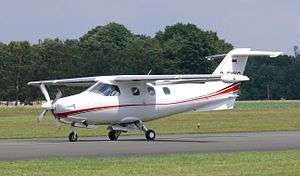Extra EA-400
The Extra EA-400 is a six-seat, single-engined, high-wing monoplane produced by Extra Flugzeugbau GmbH. The EA-400 is powered by a liquid-cooled Continental Voyager turbocharged piston engine.
| Extra EA-400 | |
|---|---|
 | |
| Role | Six-seat utility aircraft |
| National origin | Germany |
| Manufacturer | Extra Flugzeugbau GmbH |
| First flight | 23 April 1996 |
| Introduction | 1998 |
| Status | In private service |
Design and development
Started by Walter Extra, the company manufactures aerobatic airplanes almost exclusively, with their latest products being the Extra EA-300 series. This changed with the introduction of the EA-400, a cross-country pressurized airplane with many exclusive features including carbon fiber construction, cantilevered high wing, and a water-cooled Teledyne Continental TSIOL 550C engine. This exotic engine is simultaneously a great asset and a challenge for the Extra 400: it is immune to shock cooling during descents, but troublesome and costly to operate, especially in hot climates.
The airframe was designed with engineering help from the Technical University of Delft in Holland under leadership from Prof. Egbert Torenbeek and with contributions of Mr Loek Boermans for airfoil design.
The aircraft's Fowler flaps feature a completely recessed mechanism and achieve a remarkable reduction of stall speed from 76 to 58 knots in landing configuration at maximum takeoff weight.
The landing gear was designed and manufactured by Gomolzig in Germany. It is unusual in its geometry, very strongly built, and completely sealed behind large carbon fiber doors once retracted. Its complexity requires knowledgeable maintenance personnel and also contributes to the aircraft's high operating costs.
The optional weather radar pod is smoothly blended into the left wing tip.
All Extra 400 aircraft have been retrofitted with the Flight Into Known Icing modification.
Deicing equipment consists of Teflon boots, a heated prop, a heated pilot side windscreen, dual heated pitot tubes and static ports, and a heated stall sensor connected to the autopilot.
The deicing equipment is powered by a pair of large alternators (100 and 85 amps) that also feed the AC compressor located in the tail.
The cockpit is unusually wide and comfortable with good forward and lateral visibility. Avionics are conventional with a full set of instruments for each of the two crew and a central stack.
STCs for upgrades to modern GPS navigators and "glass cockpit" displays are available, but the only autopilot certified is the STEC 55X.
An improved propeller with the "b" type blades is available from MT-Propeller under FAA Form 337 Major Modification. It increases climb performance and cruise speed. Time to climb to FL200 is 20 minutes and cruise speed at 75% power ranges from 200 knots at 16'000 ft to a maximum of 220 knots at FL 250 (at MTOW and under ISA conditions).
The passenger cabin is air-conditioned and offers four seats in a club arrangement with a folding table. It is much roomier than one would expect in this aircraft category and similar in size to that of the smaller jets such as the Eclipse 550. The single-skin pressurized vessel is very rigid, resulting in a relatively low level of noise and vibration in the cabin.
The Extra 400 was very costly to manufacture, requiring 16'000 hours of labor, and carried a price tag of $1 million. Despite the aircraft's qualities, only 27 were built before the company ran into financial trouble.
Accidents & Incidents
- [1]A fatal accident occurred upon delivery of the first customer aircraft on August 21, 1998, due to flying into a storm, and this caused German authorities to impose a type rating on Extra 400 pilots which was withdrawn in December 2015.
- [2]Another Extra 400 was lost to an engine failure on March 10, 2018, causing the aircraft to ditch in a field in Sharpsburg North Carolina with no casualties. The sole occupant was not injured.
Specifications (Extra EA-400)
Data from Extra EA-400 Standard Specification, Pilots Information Manual[5][6]
General characteristics
- Crew: 1
- Capacity: 5 passengers
- Length: 9.57 m (31 ft 5 in)
- Wingspan: 11.5 m (37 ft 9 in)
- Height: 3.09 m (10 ft 2 in)
- Empty weight: 1,500 kg (3,307 lb)
- Max takeoff weight: 1,999 kg (4,407 lb)
- Powerplant: 1 × Continental TSIOL-550-C Voyager
- 6-cyl. horizontally opposed liquid cooled turbocharged intercooled fuel-injected direct drive piston engine, 261 kW (350 hp) for takeoff, 242 kW (325 hp) continuous
Performance
- Cruise speed: 376 km/h (234 mph, 203 kn) KTAS at MTOW, 75% power, FL180 5,500 m (18,045 ft)
- Never exceed speed: 406 km/h (252 mph, 219 kn)
- Range: 2,000 km (1,300 mi, 1,100 nmi)
- Service ceiling: 7,600 m (25,000 ft)
- Rate of climb: 7.1 m/s (1,400 ft/min) at MTOW - ISA
References
- Ranter, Harro. "Accident Extra EA-400 D-EGBU, 21 Aug 1998". aviation-safety.net. Retrieved 2018-08-08.
- Ranter, Harro. "Incident Extra EA-400 N14EX, 10 Mar 2018". aviation-safety.net. Retrieved 2018-08-08.
- "Authorities: 5 Killed in Small Plane Crash in North Oklahoma". Retrieved 2018-08-08.
- Dedaj, Paulina (2018-08-04). "Oklahoma plane crash victims were from Kansas, authorities say". Fox News. Retrieved 2018-08-08.
- "Extra EA-400 Standard Specification" (PDF). Extra Aircraft. Archived from the original (PDF) on 2007-04-12. Retrieved 2009-02-22.
- "Extra EA-400 pilot Information Manual" (PDF). Extra Flugzeugproduktions-und Vertriebs-GmbH. Retrieved 2009-02-22.
External links
- European Aviation Safety Agency: TYPE-CERTIFICATE DATA SHEET (EA 400)